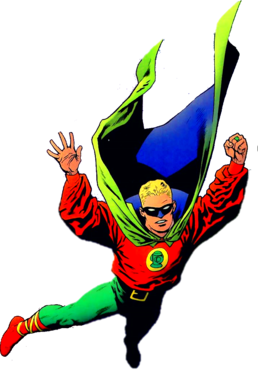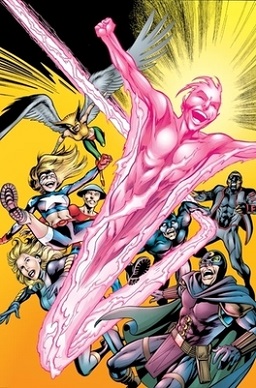
The Justice Society of America (JSA) is a superhero team appearing in American comic books published by DC Comics. It was conceived by editor Sheldon Mayer and writer Gardner Fox during the Golden Age of Comic Books. It first appeared in All Star Comics #3, making it the first team of superheroes in comic books. Its original members were Doctor Fate, Hourman, the Spectre, Sandman, Atom, the Flash, Green Lantern and Hawkman.

Power Girl, also known as Kara Zor-L, Karen Starr, and Paige Stetler, is a superheroine appearing in American comic books by DC Comics, making her first appearance in All Star Comics #58. Power Girl is the cousin of the superhero Superman, but from an alternate universe in the fictional multiverse in which DC Comics stories are set. Originally hailing from the world of Earth-Two, first envisioned as the home of DC's wartime heroes as published in 1940s comic books, Power Girl becomes stranded in the main universe where DC stories are set, and becomes acquainted with that world's Superman and her own counterpart, Supergirl.

Black Canary is the name of two superheroines appearing in American comic books published by DC Comics. As one of the earliest female superheroes in the DC Comics universe, the character has made numerous appearances in prominent team-up titles, including the Justice Society of America and Justice League of America. The Black Canary persona has been adopted by two individuals, portrayed as a legacy heroes with a mother-daughter relationship between the two. Following DC's New 52 initiative, Black Canary was briefly amalgamated as a single character before the mother-and-daughter dynamic was restored to continuity, the history formerly established retroactively added as part of the second Black Canary's history.

Black Adam (Teth-Adam) is a fictional character appearing in American comic books published by DC Comics. He was created by Otto Binder and C. C. Beck, and first appeared in the debut issue of Fawcett Comics' The Marvel Family comic book in December 1945. Since DC Comics licensed and acquired Fawcett's characters in the 1970s, Black Adam has endured as one of the most popular archenemies of the superhero Captain Marvel / Shazam and the Marvel Family alongside Doctor Sivana and Mister Mind.
The Injustice Society is a group of supervillains in the DC Comics Universe. They are the main antagonists of the Justice Society of America.

Sanderson "Sandy" Hawkins, formerly known as Sandy the Golden Boy, Sands, Sand and currently known as Sandman, is a character appearing in comics published by DC Comics. He was created by writer Mort Weisinger and artist Paul Norris, he first appeared in Adventure Comics #69. After being unutilized for several years, he was reintroduced by writers David S. Goyer and Geoff Johns in the comic JSA in the late 1990s and with a greatly expanded set of powers and responsibilities. He eventually took on the name of Sandman, succeeding his former mentor.

Courtney Elizabeth Whitmore, known as Stargirl and formerly as the second Star-Spangled Kid, is a superhero created by Geoff Johns and Lee Moder who appears in American comic books published by DC Comics. The character's name, appearance, and personality were patterned after Johns' 18-year-old sister Courtney, who died in the explosion of TWA Flight 800 in 1996.

Jakeem Thunder, initially called J.J. Thunder, is a fictional character in the DC Comics Universe, a member of the superhero team the Justice Society of America.

Ultra-Humanite is a supervillain appearing in American comic books published by DC Comics. He first appeared as a recurring adversary of Superman, and was among the first villains faced by him. He was designed to be the polar opposite of Superman; while Superman is a hero with superhuman strength, Ultra-Humanite is a criminal mastermind who has a crippled body but a highly advanced intellect. The Ultra-Humanite served as Superman's nemesis until Alexei Luthor and his Silver Age counterpart Lex Luthor were introduced in the comics. The origins of the super-criminal known as the Ultra-Humanite are shrouded in mystery. Even he claims not to remember his true name or appearance and attributes his vast intellect and mental prowess to scientific experiments of an unknown nature.

Jason Peter "Jay" Garrick is a superhero appearing in American comic books published by DC Comics. He is the first character known as the Flash. The character first appeared in Flash Comics #1, created by writer Gardner Fox and artist Harry Lampert.

Albert Rothstein is a superhero appearing in American comic books published by DC Comics. Atom Smasher is known for his power of growth and super strength.

Gog is the name of several fictional characters in the comics published by DC Comics. The first version first appeared in New Year's Evil: Gog #1, and was created by Mark Waid and Jerry Ordway.

The Wizard is a supervillain appearing in American comic books published by DC Comics. He is a magic-user who is a known enemy of the Justice Society of America, Superman of Earth-Two, and the Justice League of America.

Icicle is the name of two supervillains appearing in comic books published by DC Comics: Joar Mahkent and Cameron Mahkent.

Hourman is a fictional superhero who was created by Roy Thomas, Dann Thomas and first appeared in Infinity Inc. #20 as Rick Tyler, son of the original Hourman, who quickly joined Infinity Inc. as the second Hourman in #21 of that book.

Alan Wellington Ladd-Scott is a superhero appearing in American comic books published by DC Comics, and the first character to bear the name Green Lantern. He fights evil with the aid of his mystical ring, which grants him a variety of powers. He was created by Martin Nodell and Bill Finger, first appearing in the comic book All-American Comics #16, published on July 10, 1940.

"The Lightning Saga" is a comic book crossover story arc that took place in DC Comics' two flagship team books: Justice League of America and Justice Society of America. It was written by Brad Meltzer and Geoff Johns, and illustrated by Ed Benes, Dale Eaglesham, and Shane Davis. It is notable for re-introducing the Legion of Super-Heroes in the post-Infinite Crisis era.

Jesse Chambers is a superhero appearing in American comic books published by DC Comics. Chambers, who mainly uses the superhero name Jesse Quick and briefly Liberty Belle, is the daughter of Golden Age heroes Johnny Quick and Liberty Belle. She inherited both of her parents' powers of superhuman speed and super-strength, and, unlike other speedsters, is also capable of flight. She was initially a scholar of superheroes who was recruited into the Justice Society of America after aiding them. She is a longtime ally of The Flash, despite their often difficult relationship, and has been a core member of the Justice Society of America, Titans and Justice League.

The Thunderbolt (Yz) is a fictional character appearing in comics published by DC Comics and the name of other fictional genie variants within the 5th Dimension as well. Yz was originally portrayed as a genie-like character who hosts Johnny Thunder and then later Jakeem Thunder. He also appeared as an original and ordinary member of the Justice Society of America.


















